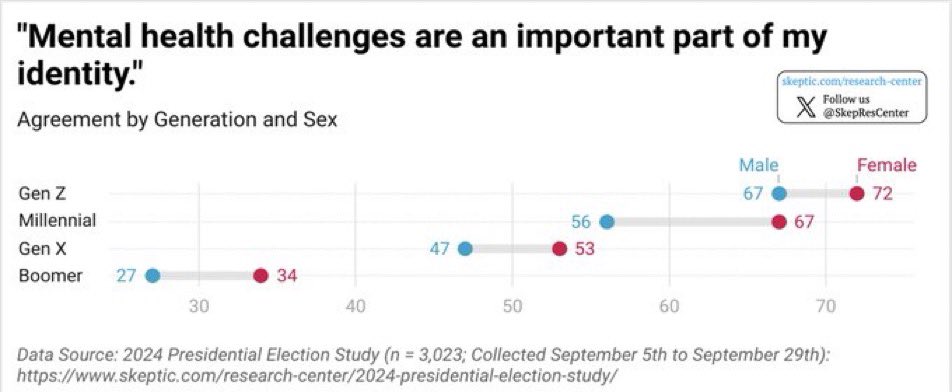There’s no denying it anymore: we are in the middle of a mental health epidemic, and younger generations are increasingly showing it to us. The numbers are absolutely staggering. A recent study shows that 67% of both Gen Z males and females agree that their mental health struggles are an important part of their identity. Millennials aren’t far behind, with 56% of men and 67% of women sharing the same sentiment.
This isn’t just a few isolated cases. It’s a growing reality, a tidal wave of anxiety, depression, and emotional distress sweeping through younger people. The fact that so many young people are identifying with their mental health challenges points to something much deeper: we’re no longer just dealing with mental health as a temporary hurdle, but as a defining part of who these individuals believe they are.
This begs the question: How did mental health struggles become such an integral part of identity for so many? And more importantly, how do we confront this epidemic head-on before it consumes the future of an entire generation?
The Mental Health Crisis: A Silent Epidemic
Mental health challenges have been around forever, but never before have they been so widespread, so normalized, and so deeply ingrained in the way younger generations see themselves (don’t get me wrong, it must be amazing for your pharmaceutical stocks, not so much for your children…). For many, mental health struggles aren’t just an occasional battle, they’re a constant presence. The idea that mental health struggles are a part of identity is concerning, not because people are becoming more open about their struggles, but because so many feel as though their emotional pain is now who they are.
Gen Z stands out in this growing crisis, with 67% of both males and females agreeing that their mental health struggles define them. Millennials are similarly affected, particularly women, 67% of whom identify strongly with their emotional difficulties. This epidemic isn’t just a wave, it’s a tsunami, and it’s showing no signs of slowing down.
The data doesn’t lie: something is seriously wrong. But why? What has led to this mental health crisis that’s threatening to become the new normal?
The Pressure Cooker: Life in the Modern World
If you’re a young person today, the pressures you face are immense. Social media has taken over, creating a culture of constant comparison. Financial pressures are at an all-time high, with student debt, stagnant wages, and an increasingly competitive job market making the future feel more uncertain than ever. Add to that the global pandemic, political upheaval, climate change, and a feeling of existential dread, and it’s no wonder that younger generations are feeling the strain like never before.
But while these pressures explain the rising rates of anxiety, depression, and emotional exhaustion, they don’t explain why so many young people now identify with their mental health struggles.
When Struggles Become Identity
Here’s where the danger lies. We all face difficulties at some point in our lives, but younger generations seem to be internalizing their struggles, turning them into the core of their identity. Mental health has become something of a badge, a part of who they are, not just what they experience.
It’s easy to see how this happens. Most of them have been robbed of their childhood. And when you’re constantly bombarded by images of perfection on social media, it’s hard not to feel like you’re falling short. When your daily reality is filled with stress, anxiety, and uncertainty, it’s hard not to believe that this is just who you are. But here’s the truth: mental health struggles are a part of life, but they don’t have to define your identity.
The danger of defining yourself by your struggles is that it creates a cycle that’s hard to break free from. When we internalize mental health challenges as part of who we are, it becomes harder to imagine life without them. And once you start to believe that your anxiety, depression, or other emotional difficulties are who you are, it becomes far more difficult to seek help and make meaningful changes. It becomes your new normal.
The Mental Health Epidemic Is Real. So What’s the Solution?
It’s clear that we’re facing an epidemic of mental health struggles in younger generations. But what do we do about it? How do we help Gen Z and Millennials break free from the cycle of defining themselves by their mental health issues? How do we prevent this epidemic from continuing to spread?
1. Start by Acknowledging the Scope of the Problem
The first step in tackling this epidemic is acknowledging that it exists. We can no longer dismiss mental health challenges as personal failings or temporary phases. This is a collective issue that needs collective attention. If 67% of Gen Z and Millennials identify with their struggles, then we need to start viewing mental health as the crisis it is and begin implementing systems and supports that can address it.
2. Offer Tools for Detachment
One of the most crucial steps in combatting the mental health epidemic is helping people detach their struggles from their identity. Yes, mental health challenges are real, but they don’t define who you are. You are not your anxiety. You are not your depression.
We need to provide young people with the tools to step outside their struggles and see them for what they are, temporary states that can be managed, improved, and even overcome. This requires widespread access to therapy, mindfulness practices, and self-awareness techniques that help people identify and manage their emotions without internalizing them. The information is available, but i’m unsure this is what they are searching or scrolling for online.
3. Limit the Negative Impact of Social Media
Social media is undoubtedly playing a major role in this epidemic. It has created an environment where comparison is constant, and everyone feels the pressure to perform. If you’re constantly comparing your worst moments to someone else’s highlight reel, it’s no surprise that mental health struggles start to feel like a permanent part of who you are.
Limiting social media use, curating your online environment, and taking breaks from the constant bombardment of “perfect” lives can help reduce the pressure that fuels this crisis.
4. Redefine Success and Self-Worth
One of the biggest contributors to the mental health epidemic is the distorted view of success that dominates modern life. The traditional markers of success (wealth, status, beauty) are now more unattainable than ever, and young people are left feeling like they’ll never measure up.
We need to redefine success and self-worth. True success isn’t about external validation or perfection. It’s about personal growth, emotional resilience, and building a meaningful life based on your own values, not the expectations of others. We need to help young people understand that they are valuable, worthy, and enough just as they are, regardless of how much money they make or how many Instagram followers they have.
Breaking the Cycle of the Mental Health Epidemic
This mental health epidemic is real, and it’s affecting millions of young people. But while the problem is vast, it’s not unsolvable. By raising awareness, offering tools for emotional resilience, limiting the impact of social media, and redefining success, we can start to shift the narrative.
If you’re struggling with your mental health and feel like it’s becoming a part of your identity, know this: You are not your struggles. You are capable of healing. You are worthy of a life that isn’t defined by your pain.
Let’s work together to break the cycle of this epidemic and build a future where mental health struggles are addressed, not internalized. As life coaches, we are about to get busier than ever…








Comments